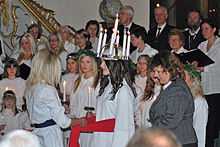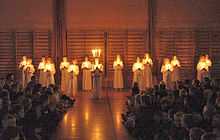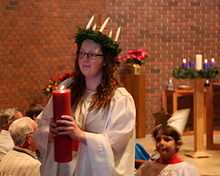Saint Lucy's Day
| Saint Lucy's Day | |
|---|---|
 Saint Lucy's Day 2006 | |
| Liturgical Color | purple |
| Type | Christian |
| Date | December 13 |
| Next time | 13 December 2014 |
| Frequency | annual |
Saint Lucia's Day is the church feast day dedicated to Lucia of Syracuse (d.304), also known as Saint Lucy, and is observed on 13 December.[1] St. Lucia’s Day is celebrated most commonly in Italy and in Scandinavia, with each emphasizing a different aspect of the story. It is one of the very few saint days observed in Scandinavia. In traditional celebrations in Scandinavia, Saint Lucy comes as a young woman with lights and sweets. In some forms, a procession is headed by one girl wearing a crown of candles (or lights), while others in the procession hold only a single candle each.
Origins

Saint Lucia is one of the few saints celebrated by the overwhelmingly Lutheran Nordic people — Danes; Swedes; Finns and Norwegians. The St. Lucy's Day celebrations retain many indigenous Germanic pagan, pre-Christian midwinter elements. Some of the practices associated with the day predate the adoption of Christianity in Scandinavia, and like much of Scandinavian folklore and even religiosity, is centered on the annual struggle between light and darkness.
The Nordic observation of St. Lucy is first attested in the Middle Ages, and continued after the Protestant Reformation in the 1520s and 1530s, although the modern celebration is only about 200 years old. It is likely that tradition owes its popularity in the Nordic countries to the extreme change in daylight hours between the seasons in this region.
The pre-Christian holiday of Yule, or jól, was the most important holiday in Scandinavia and Northern Europe. Originally the observance of the winter solstice, and the rebirth of the sun, it brought about many practices that remain in the Advent and Christmas celebrations today. The Yule season was a time for feasting, drinking, gift-giving, and gatherings, but also the season of awareness and fear of the forces of the dark.
13 December
It was commonly believed in Scandinavia as late as the end of the 19th century that this was the longest night of the year, coinciding with Winter Solstice.[2] The same can be seen in the poem "A Nocturnal upon S. Lucy's Day, Being the Shortest Day" by the English poet John Donne.
While this does not hold for our current Gregorian calendar, a discrepancy of 8 days would have been the case in the Julian calendar during the 14th century, resulting in Winter solstice falling on December 13. With the original adoption of the Gregorian calendar in the 16th century the discrepancy was 10 days and had increased to 11 days in the 18th century when Scandinavia adopted the new calendar, with Winter solstice falling on December 9.
It is very difficult to tell the exact date of the Winter solstice without modern equipment (although the Neolithic builders of the Newgrange monument seem to have managed it). The day itself is not visibly shorter than the several days leading up to and following it and although the actual Julian date of Winter solstice would have been on the December 15 or 14 at the time when Christianity was introduced to Scandinavia, December 13 could well have lodged in peoples mind as being the shortest day.
The choice of 13 December as Saint Lucy's day, however, obviously predates the 8 day error of the 14th century Julian calendar. This date is attested in the pre-Tridentic Monastic calendar, probably going back to the earliest attestations of her life in the 6th and 7th centuries, and it is the date used throughout Europe.
At the time of Saint Lucy's death, Winter solstice fell on December 21 and the date of the birth of Christ on the 25th. The latter was also celebrated as being the day when the Sun was born, the birthday of Sol Invictus, as can be seen in the Chronography of 354. This latter date was thought by the Romans to be the Winter solstice and it is natural to think of the sun being born that day. Early Christians considered this a likely date for their saviour's nativity, as it was commonly held that the world was created on Spring equinox (thought to fall on March 25 at the time), and that Christ had been conceived on that date, being born 9 months later on Winter solstice.[3]
Lussi
Lussinatta, the Lussi Night, was marked in Sweden December 13.[4] Then Lussi, a female being with evil traits, like a female demon or witch, was said to ride through the air with her followers, called Lussiferda. This itself might be an echo of the myth of the Wild Hunt, called Oskoreia in Scandinavia, found across Northern, Western and Central Europe.
Between Lussi Night and Yule, trolls and evil spirits, in some accounts also the spirits of the dead, were thought to be active outside. It was believed to be particularly dangerous to be out during Lussi Night. According to tradition, children who had done mischief had to take special care, since Lussi could come down through the chimney and take them away, and certain tasks of work in the preparation for Yule had to be finished, or else the Lussi would come to punish the household. The tradition of Lussevaka – to stay awake through the Lussinatt to guard oneself and the household against evil, has found a modern form through throwing parties until daybreak. Another company of spirits was said to come riding through the night around Yule itself, journeying through the air, over land and water.
St. Lucy/Lucia

According to the traditional story, Lucy was born of rich and noble parents about the year 283. Her father was of Roman origin, but died when she was five years old,[5] leaving Lucy and her mother without a protective guardian. Although no sources for her life-story exist other than in hagiographies, St. Lucy, whose name Lucia refers to "light" (Lux, lucis), is believed to have been a Sicilian saint who suffered a sad death in Syracuse, Sicily around AD 310.[6] Jacobus de Voragine's Golden Legend first compiled in the 13th century, a widespread and influential compendium of saint's biographies, records her story thus: She was seeking help for her mother's long-term illness at the shrine of Saint Agnes, in her native Sicily, when an angel appeared to her in a dream beside the shrine. As a result of this, Lucy became a devout Christian, refused to compromise her virginity in marriage and was denounced to the Roman authorities by the man she would have wed. They threatened to drag her off to a brothel if she did not renounce her Christian beliefs, but were unable to move her, even with a thousand men and fifty oxen pulling. So they stacked materials for a fire around her instead and set light to it, but she would not stop speaking, insisting that her death would lessen the fear of it for other Christians and bring grief to non-believers. One of the soldiers stuck a spear through her throat to stop these denouncements, but to no effect. Soon afterwards, the Roman consulate in charge was hauled off to Rome on charges of theft from the state and beheaded. Saint Lucy was able to die only when she was given the Christian sacrament.[7] All the details of her life are the conventional ones associated with female martyrs of the early 4th century. John Henry Blunt views her story as a Christian romance similar to the Acts of other virgin martyrs.[8] In another story, Saint Lucy was working to help Christians hiding in the catacombs during the terror under the Roman Emperor Diocletian, and in order to bring with her as many supplies as possible, she needed to have both hands free. She solved this problem by attaching candles to a wreath on her head.
There is little evidence that the legend itself derives from the folklore of northern Europe, but the similarities in the names ("Lussi" and "Lucia"), and the date of her festival, December 13, suggest that two separate traditions may have been brought together in the modern-day celebrations in Scandinavia.
Celebration
Italy
Celebrations take place on the 13th of December and in May. Saint Lucy or Lucia, whose name comes from the Latin word "lux" meaning light, links with this element and with the days growing longer after the Winter solstice.[9]
St. Lucia is the patron saint of the city of Syracuse (Sicily). Sicilians recall a legend that holds that a famine ended on her feast day when ships loaded with grain entered the harbor. Here, it is traditional to eat whole grains instead of bread on December 13. This usually takes the form of cuccia,[9] a dish of boiled wheat berries often mixed with ricotta and honey, or sometimes served as a savory soup with beans.[10]
St. Lucy is also popular among children in some regions of North-Eastern Italy, namely Trentino, East Lombardy (Bergamo, Brescia, Cremona, Lodi and Mantua), parts of Veneto, (Verona), parts of Emilia-Romagna, (Piacenza, Parma, Reggio Emilia and Bologna), and all of Friuli, where she is said to bring gifts to good children and coal to bad ones the night between December 12 and 13. According to tradition, she arrives in the company of a donkey and her escort, Castaldo. Children are asked to leave some coffee for Lucia, a carrot for the donkey and a glass of wine for Castaldo. They must not watch Santa Lucia delivering these gifts, or she will throw ashes in their eyes, temporarily blinding them.
Malta
Santa Luċija is the patron saint of the villages of Mtarfa (Malta) and Santa Luċija (Gozo).[9] On the 13th December Malta also celebrates Republic Day.
In the Nordic countries
In Sweden, Denmark, Norway, and Finland, Lucy (called Lucia) is venerated on December 13 in a ceremony where a girl is elected to portray Lucia. Wearing a white gown with a red sash and a crown of candles on her head, she walks at the head of a procession of women, each holding a candle. The candles symbolize the fire that refused to take St. Lucia's life when she was sentenced to be burned. The women sing a Lucia song while entering the room, to the melody of the traditional Neapolitan song Santa Lucia; the Italian lyrics describe the view from Santa Lucia in Naples, the various Scandinavian lyrics are fashioned for the occasion, describing the light with which Lucia overcomes the darkness. Each Scandinavian country has lyrics in their native tongues. After finishing this song, the procession sings Christmas carols or more songs about Lucia.
Sweden


The custom involves the eldest daughter arising early and wearing her Lucy garb of white robe, red sash, and a wire crown covered with whortleberry-twigs with nine lighted candles fastened in it awakens the family, singing "Santa Lucia", serving them coffee and saffron buns (St. Lucia buns), thus ushering in the Christmas season.[11]
Although St. Lucia's Day is not an official holiday in Sweden, it is a popular occasion in Sweden. At many universities, students hold big formal dinner parties since this is the last chance to celebrate together before most students go home to their families for Christmas.
The Swedish lyrics to the Neapolitan song Santa Lucia have traditionally been either Natten går tunga fjät (The Night walks with heavy steps)[11] or Santa Lucia, ljusklara hägring (Saint Lucy, bright mirage). There is also a modern version with simpler lyrics for children: Ute är mörkt och kallt (Outside it's dark and cold).
The modern tradition of having public processions in the Swedish cities started in 1927 when a newspaper in Stockholm elected an official Lucia for Stockholm that year. The initiative was then followed around the country through the local press. Today most cities in Sweden appoint a Lucia every year. Schools elect a Lucia and her maids among the students and a national Lucia is elected on national television from regional winners. The regional Lucias will visit shopping malls, old people's homes and churches, singing and handing out gingernut cookies (pepparkakor). Guinness World Records has noted the Lucia procession in Ericsson Globe in Stockholm as the largest in the world, with 1200 participants from Adolf Fredrik's Music School, Stockholms Musikgymnasium and Stockholmläns Blåsarsymfoniker.
Now boys take part in the procession as well, playing different roles associated with Christmas. Some may be dressed in the same kind of white robe, but with a cone-shaped hat decorated with golden stars, called stjärngossar (star boys); some may be dressed up as "tomtenissar", carrying lanterns; and some may be dressed up as gingerbread men. They participate in the singing and also have a song or two of their own, usually Staffan Stalledräng, which tells the story about Saint Stephen, the first Christian martyr, caring for his five horses. Some trace the "re-birth" of the Lucia celebrations in Sweden to the tradition in German Protestant families of having girls dressed as angelic Christ children, handing out Christmas presents. The Swedish variant of this white-dressed Kindchen Jesus, or Christkind, was called Kinken Jes, and started to appear in upper-class families in the 18th century on Christmas Eve with a candle-wreath in her hair, handing out candy and cakes to the children. Another theory claims that the Lucia celebration evolved from old Swedish traditions of “star boys” and white-dressed angels singing Christmas carols at different events during Advent and Christmas. In either case, the current tradition of having a white-dressed woman with candles in her hair appearing on the morning of the Lucia day started in the area around Vänern in the late 18th century and spread slowly to other parts of the country during the 19th century.

A traditional kind of bun, Lussekatt ("St. Lucia Bun"), made with saffron, is normally eaten on this day.
In 2008 there was some controversy over males as Lucia, with one male who was elected Lucia at a high school being blocked from performing, and another performing together with a female.[12][13] In another case a six-year-old boy was not allowed to appear with a Lucia crown because the school said it couldn't guarantee his safety.[14]
Finland
The Finnish celebrations have been historically tied to Swedish culture and the Swedish-speaking Finns. They observe "Luciadagen" a week before the Winter Solstice. St Lucy is celebrated as a “beacon of brightness” in the darkest time of year. [15] The first records of St. Lucy celebrations in Finland are from 1898, and the first large celebrations came in 1930, a couple of years after the popularization of the celebrations in Sweden. The St. Lucy of Finland has been elected since 1949 and she is crowned in the Helsinki Cathedral. Local St. Lucys are elected in almost every place where there is a Swedish populace in Finland. The Finnish-speaking population has also lately begun to embrace the celebrations.[16]
Denmark

In Denmark, the Day of Lucia (Luciadag) was first celebrated on December 13, 1944. The tradition was directly imported from Sweden by initiative of Franz Wend, secretary of Föreningen Norden, as an attempt "to bring light in a time of darkness”. Implicitly it was meant as a passive protest against German occupation during the Second World War but it has been a tradition ever since.
Although the tradition is imported from Sweden, it differs somewhat in that the celebration has always been strongly centered on Christianity and it is a yearly local event in most churches in conjunction with Christmas. Schools and kindergartens also use the occasion to mark the event as a special day for children on one of the final days before the Christmas holidays, but it does not have much impact anywhere else in society.
There are also a number of additional historical traditions connected with the celebration, which are not widely observed. The night before candles are lit and all electrical lights are turned off, and on the Sunday closest to December 13 Danes traditionally attend church.
The Danish versions of the Neapolitan song clearly reflect its close connection to Christianity. The best known version is Holger Lissners version from 1982, Sankta Lucia.
Saint Lucy's Day is celebrated also in the Faroe Islands.
Norway
Historically Norwegians considered what they called Lussinatten the longest night of the year and no work was to be done. From that night until Christmas, spirits, gnomes and trolls roamed the earth. Lussi, a feared enchantress, punished anyone who dared work. Legend also has it that farm animals talked to each other on Lussinatten, and that they were given additional feed on this longest night of the year. [17] The Lussinatt, the night of December 13, was largely forgotten in Norway at the beginning of the 20th century, though still remembered as an ominous night, and also celebrated in some remote areas.
It was not until after World War II that the modern celebration of Lucia in Norway was imported from Sweden, and became adopted on a larger scale. It is now again observed all over the country.
Like the Swedish tradition, and unlike the Danish, Lucia is largely a secular event in Norway, and is observed in kindergartens and schools (often through secondary level). However, it has in recent years also been incorporated in the Advent liturgy in the Church of Norway. The boys are often incorporated in the procession, staging as magi with tall hats and star-staffs. Occasionally, anthems of Saint Stephen are taken in on behalf of the boys.
For the traditional observance of the day, school children form processions through the hallways of the school building carrying candles, and hand out lussekatt buns. While rarely observed at home, parents often take time off work to watch these school processions in the morning, and if their child should be chosen Lucia it is considered a great honor. Later on in the day, the procession usually visits local retirement homes, hospitals, and nursing homes.
Saint Lucia (Caribbean)

In Saint Lucia, a tiny island in the Caribbean named after its patron saint, St. Lucy, December 13 is celebrated as National Day. The National Festival of Lights and Renewal is held the night before the holiday, in honour of St Lucy of Syracuse the saint of light. In this celebration, decorative lights (mostly bearing a Christmas theme) are lit in the capital city of Castries; artisans present decorated lanterns for competition; and the official activities end with a fireworks display.[18] In the past, a jour ouvert celebration has continued into the sunrise of 13 December.
United States

In the Evangelical Lutheran Church in America (ELCA), which is the successor church to hundreds of Scandinavian and German Lutheran congregations, St. Lucia is treated as a commemoration on December 13, in which red vestments are worn. Usually, the Sunday in Advent closest to December 13 is set aside for St. Lucia, in which the traditional Scandinavian procession is observed.
Notes
- ↑ William D. Crump The Christmas Encyclopedia, 2006 3d ed. 2013 "Prior to the adoption of the Gregorian calendar in the sixteenth century, St. Lucia's Day fell on the winter solstice, which poses a factor in her association with light, and her day Christianized a day formerly associated with the pagan Germanic goddess Berchta..."
- ↑ Nordisk familjebok (1876-1926)
- ↑ Christmas (Encyclopædia Britannica)
- ↑ "The Swedish Syndrome: St.Lucy´s day, how a Sicialian woman can be worshiped in the far North"<1--can a better reference be located?-->
- ↑ "St. Lucy", St. Lucy's Church, Scranton, Pennsylvania
- ↑ Hamer, Richard. 2006. Guilte Legende. Oxford University Press for the Early English Text Society. Volume 1, p 25.
- ↑ Hamer, Richard. 2006. Volume 1, pp 22–25.
- ↑ Blunt, John Henry Blunt. The Annotated Book of Common Prayer, London, 1885:176
- ↑ 9.0 9.1 9.2 Alio, Jacqueline. "Saint Lucy - Sicily's Most Famous Woman", Best of Sicily Magazine, 2009
- ↑ "Lussekatter and Cuccia for St. Lucy’s Day", Smithsonian Magazine, 10 December 2010
- ↑ 11.0 11.1 Matthews, Jeff. "Everybody Loves Lucy", University of Maryland University College - Italian Studies
- ↑ Boys blocked from bearing 'girls-only' Lucia crown The Local
- ↑ Johan Gustafsson – med rätt att lussa Metro.se
- ↑ Sexåringen, luciakronan och säkerheten Aftonbladet.se
- ↑ "Winter Solstice celebrations in Finland", Euronews, 14 December 2012
- ↑ Folkhälsan: Lucia – legend och historia.
- ↑ Steves, Rick. "Norwegian Christmas", Rick Steves' Europe
- ↑ National Day - Festival of Lights and Renewal
References
- Eriksson, Stig A. (2002). Christmas traditions and performance rituals: a look at Christmas celebrations in a Nordic context. 2002. Applied Theater Researcher. No. 3. 6/3
- Nygaard, J. (1992). Teatrets historie i Europa ("~ History in Europe"). Volume 1. Oslo: Spillerom.
- NRK radio (2002). Språkteigen. NRK radio. December 2002.
External links
| Wikimedia Commons has media related to Saint Lucy's Day. |
| Wikisource has original text related to this article: |
- Nordisk Familjebok, article Lucia Nordisk Familjebok, 1912 (Swedish)
- "A Nocturnal upon Saint Lucy's Day," poem by John Donne (1572–1631)